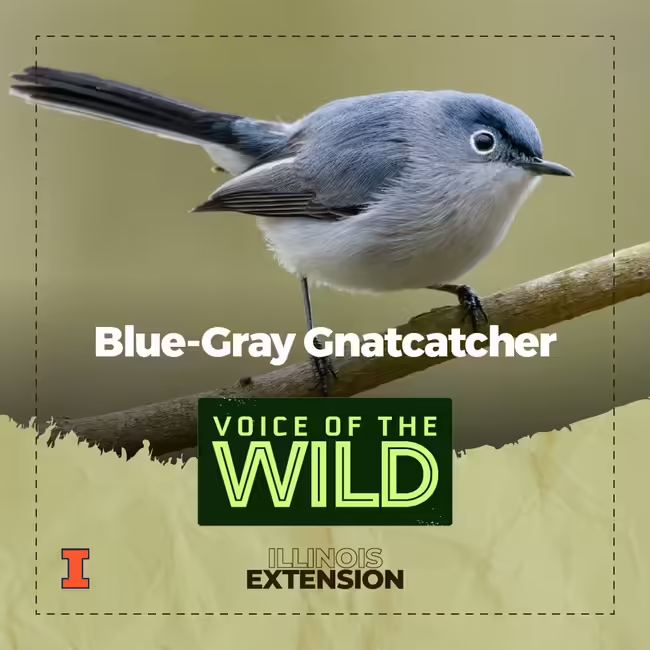
Episode Number
50
Episode Show Notes / Description
Blue-gray Gnatcatcher (Polioptila caerulea).
The scratchy-voiced little package of attitude.
Do you want to learn more bird songs, frog calls, and insect noises? Join Voice of the Wild every Friday to explore a new wild voice. We’re available on most podcast platforms, including Apple Podcasts, Spotify, and YouTube.
- Subscription links Here
- Subscribe to the Newsletter
- Listen online on our Homepage
The following Cornell Lab | Macaulay Library recordings were used in this episode:
- Blue-gray gnatcatcher complex song by Wil Hershberger (ML508505)
- Blue-gray gnatcatcher simple song by Wil Hershberger (ML508508)
- Blue-gray gnatcatcher call by Geoffrey A. Keller (ML508510)
Extras:
- Nest photograph 1: https://www.flickr.com/photos/jeff-m-bryant/17323182248
- Nest photograph 2: https://www.flickr.com/photos/rosyfinch/17755559598
Sources and more:
- https://www.allaboutbirds.org/guide/Blue-gray_Gnatcatcher
- https://www.audubon.org/field-guide/bird/blue-gray-gnatcatcher
- Dobson C, Kassenbaum D, Oehmke D, et al. 2023. Field guide to hotspots and birds in Illinois. Champaign-Urbana: Scissortail LLC.
- National Audubon Society videoguide to the birds of North America. 2004. Fullscreen. Carrboro, NC: Godfrey-Stadin Productions.
- Peterson RT, Peterson VM. 1980. A field guide to the birds : a completely new guide to all the birds of eastern and central North America. Fourth edition, completely revised and enlarged. Boston: Houghton Mifflin Company (The Peterson field guide series ; 1).
- Sibley D. 2016. Sibley birds East : field guide to birds of eastern North America. Second edition. New York: Alfred A. Knopf (Field guide to birds of eastern North America).
Transcript
This is Illinois Extension’s Voice of the Wild. A new wild voice in just a moment, so find someplace quiet, take a deep breath, and enjoy.
They may arrive a little after the Spring ephemerals have begun peaking through forest duff, but for me, spring is only here to stay once this little package of attitude graces the budding trees. Their call is small and wheezy, but persistent. The males, with a dark line angling over their eye, are easy to imagine grumpy. Both sexes have a thin white eyering and a tail that’s comparatively long for their small bodies, a trait that makes them very fun to watch flitting about the trees.
This is the Blue-gray Gnatcatcher, Polioptila caerulea from the family Polioptilidae.
The gnatcatcher has a distinctive scratchy little voice, but listen close because they have two different kinds of song - a very simple version which is just a few notes alternating back and forth and a second that is very complex and even includes little phrases stolen from other birds.
Several years ago I had the great privilege of seeing a gnatcatcher nest up close - it was only a few inches wide, but it was as beautiful as it was delicate. The out side covered with a fine layer of turquoise lichens stitched to a little cup of knitted fine hairs and spider silks. It was certainly one of the finest weavings i’ve ever seen. I’ve put a link in the description to a few photographs that i’ve found that look like the one I found. Here’s that breathy, persistent call one more time.
Thank you to the Macaulay library at the Cornell lab for our bird sounds. And thank you for tuning in to learn a new wild voice with Illinois Extension
They may arrive a little after the Spring ephemerals have begun peaking through forest duff, but for me, spring is only here to stay once this little package of attitude graces the budding trees. Their call is small and wheezy, but persistent. The males, with a dark line angling over their eye, are easy to imagine grumpy. Both sexes have a thin white eyering and a tail that’s comparatively long for their small bodies, a trait that makes them very fun to watch flitting about the trees.
This is the Blue-gray Gnatcatcher, Polioptila caerulea from the family Polioptilidae.
The gnatcatcher has a distinctive scratchy little voice, but listen close because they have two different kinds of song - a very simple version which is just a few notes alternating back and forth and a second that is very complex and even includes little phrases stolen from other birds.
Several years ago I had the great privilege of seeing a gnatcatcher nest up close - it was only a few inches wide, but it was as beautiful as it was delicate. The out side covered with a fine layer of turquoise lichens stitched to a little cup of knitted fine hairs and spider silks. It was certainly one of the finest weavings i’ve ever seen. I’ve put a link in the description to a few photographs that i’ve found that look like the one I found. Here’s that breathy, persistent call one more time.
Thank you to the Macaulay library at the Cornell lab for our bird sounds. And thank you for tuning in to learn a new wild voice with Illinois Extension